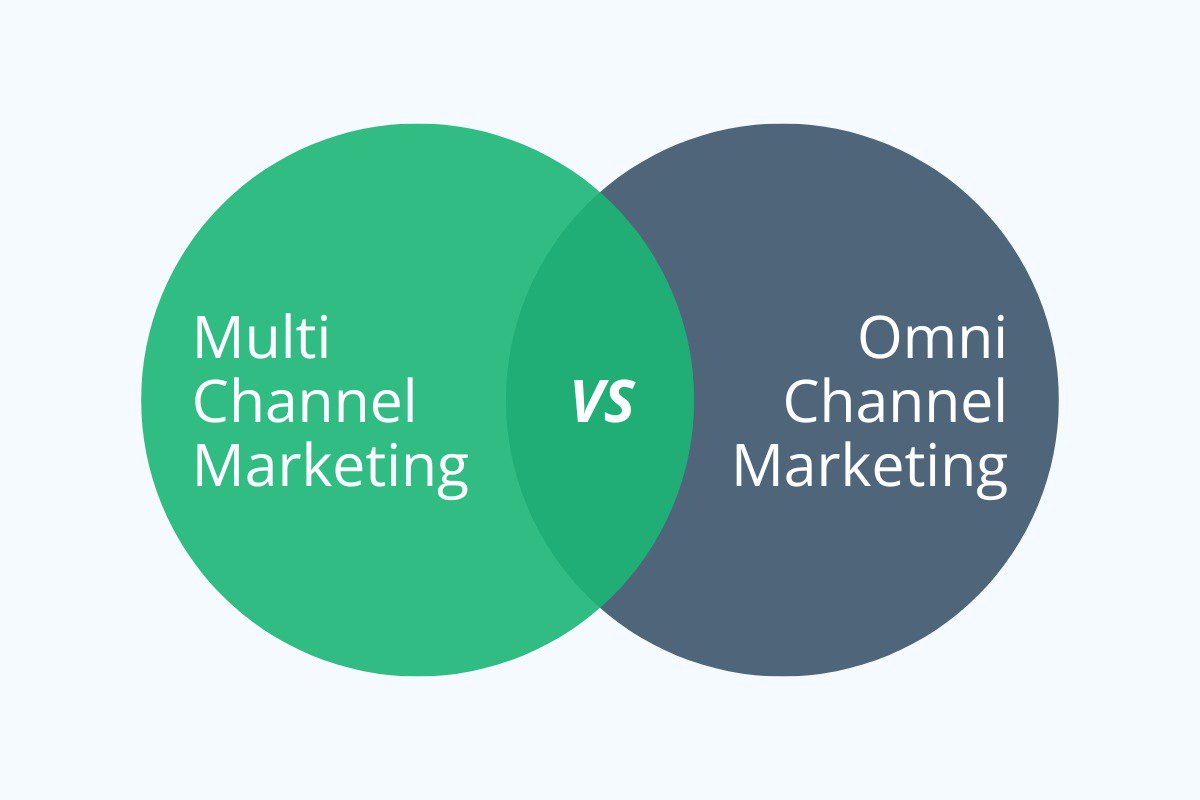Choosing between multi-channel and omnichannel marketing can significantly impact your business growth. While both strategies aim to reach your audience, how they engage with customers—and the results they deliver—differ greatly. As a business owner, understanding these approaches and weighing the benefits of multi-channel marketing vs omnichannel can help you decide on the best strategy for your goals.
Key Takeaways:
- Multi-Channel Marketing: Uses separate platforms (e.g., email, social media, in-store) to reach customers, with each operating independently. It broadens reach but can feel disjointed due to limited integration. Suitable for smaller businesses or tighter budgets. Example: Walmart runs distinct online and in-store campaigns without interconnected systems.
- Omnichannel Marketing: Integrates platforms (e.g., websites, apps, stores) to provide a seamless, personalized customer experience. Ensures consistent messaging and interaction across every touchpoint. Example: Nike’s app syncs online browsing with in-store shopping.
- Main Difference: Multi-channel emphasizes broad reach through independent channels, while omnichannel prioritizes a unified, customer-centered experience.
- Benefits of Omnichannel: Builds trust, loyalty, and convenience through individualized experiences. Keeps retention high by adapting to customer needs. Example: Netflix synchronizes user activity across multiple devices.
- Future Trends: Advances such as AI-driven tools, augmented/virtual reality (AR/VR), shoppable content, and integrated CRM solutions are shaping omnichannel approaches.

Multi-Channel Marketing
Multi-channel marketing relies on using independent platforms to communicate with customers. Each of these, whether it’s social media, email, or in-store experiences, functions on its own and doesn’t share information with the others. Think of it as different lines running toward the same goal: putting your brand in front of more people.
For example, a business might use Instagram ads, email campaigns, and a website to showcase the same sale. However, if a customer interacts with an ad on Instagram, it won’t affect the email they receive later or correlate with their website experience.
A key advantage of multi-channel marketing vs omnichannel marketing is its ability to expand reach. It allows brands to show up where their customers already spend time. That said, the lack of integration can make the customer experience feel disjointed. For instance, a shopper adding something to their cart on your website might visit your store and find no trace of their earlier activity.
Some businesses thrive by keeping this approach straightforward. Take Walmart, for example, which uses distinct channels to drive separate campaigns for online and in-store traffic. This approach is ideal for businesses just starting out or those working with limited resources.
Interested in exploring how multi-channel marketing fits into broader strategies? Check out these digital marketing tactics for more ideas.
Omnichannel Marketing
Omnichannel marketing aims to create a connected and seamless experience for customers by integrating all communication platforms. Unlike a traditional multi-channel approach, where systems operate in isolation, omnichannel knitting ties platforms like websites, social media, physical stores, and apps together. This ensures consistent branding and engagement, no matter which touchpoint a customer uses.
Picture reserving a product online and receiving reminders via email, followed by a smooth in-store pick-up process. Through omnichannel marketing, each channel works in unison to accommodate the customer’s actions. If a product viewed online sells out, the system might suggest another store nearby or an alternative item.
The standout quality of this approach is its focus on the customer experience. By analyzing customer data across different touchpoints, brands can adjust interactions in real time. For instance, adding items to an online shopping cart can influence what ads or messages a customer sees later on a mobile app or social media platform. This interconnected system creates a smooth, engaging experience that feels personalized.
Successful companies rely heavily on omnichannel strategies. Nike, for example, links digital and physical buying through its app, allowing customers to check stock or read reviews while visiting stores. Similarly, Walmart connects online purchases with offline pickup options, offering customers multiple ways to complete their transactions without disruption.
Personalized, consistent communication strengthens trust and loyalty. For example, synced systems can help businesses predict customer intent—like offering relevant discounts or information at just the right moment. Looking ahead, businesses adopting these methods stay one step ahead. Read more about future-focused strategies here.
At its core, an omnichannel experience makes customers feel understood and appreciated. In today’s competitive markets, achieving this is more than a strategy—it’s an expectation.
Multi-Channel Marketing vs Omnichannel Marketing
Multi-channel marketing revolves around separate strategies for each communication channel, such as email or social media, and sets unique objectives for every platform. While this approach expands audience reach, it offers little to no cohesion in message or experience. For instance, the ad your customer views on Instagram might not connect to the email promotion they receive on the same day.
Omnichannel marketing unites these touchpoints to create one integrated experience. It puts the focus on the customer, aligning messaging with their individual behavior across channels. For example, a customer might browse your website, receive a personalized discount via text, and redeem the coupon in-store without needless repetition.
The distinguishing element between these approaches is alignment. Multi-channel prioritizes widespread reach via independent streams, whereas omnichannel prioritizes engagement and loyalty through interconnected interactions. The choice between them hinges on your business resources and how much emphasis you place on improving customer experience.
The Benefits of Omnichannel Marketing
One of the greatest strengths of omnichannel marketing lies in delivering consistent experiences across multiple platforms. When customers encounter the same core message—whether on a website, app, or in-store—it builds trust. Over time, customers stop noticing the boundaries between channels, and their perception of value deepens. For example, an abandoned cart on your website might trigger an email reminder, followed by a discount during their next store visit—all tied seamlessly together.
This approach also nurtures loyalty by using customer data to create personalized experiences. Loyalty programs, for instance, can benefit greatly from tailored offers based on customer behavior. Sending a birthday discount or recommending products from prior purchases makes buyers feel appreciated, which fosters return visits and repeat purchases.
A well-executed system even enhances user convenience. Netflix, for instance, remembers where a viewer paused their show and picks up immediately on any device. It may seem simple, but such thoughtful integration improves user satisfaction, highlighting how valuable seamless interactions can be.
When Should You Use Multi-Channel Marketing?
When weighing multi-channel marketing vs omnichannel marketing, scale should be considered. Multi-channel marketing is a perfect match for smaller businesses or those with limited budgets. It allows brands to engage audiences on various platforms like email, social media, or print without linking them. Managing each platform independently lets businesses focus their energy and resources one at a time. For example, a local coffee shop might invest in Instagram ads while building an email list to announce seasonal promotions.
In certain situations, multi-channel strategies work better. Short campaigns or events requiring speed often thrive in this model. For example, a flash sale communicated across independent platforms can be executed without investing in unified systems, making it both simple and cost-efficient.
That said, managing several standalone systems can present challenges. If messages are inconsistent across platforms, customers might feel disconnected. For instance, running a promotion on one platform and forgetting to update others can harm the overall experience.
For businesses testing the waters or operating with straightforward needs, multi-channel marketing provides a manageable entry point.
Transitioning from Multi-Channel to Omnichannel
Shifting from a multi-channel setup to an omnichannel strategy begins with centralizing your business’s customer data. Where multi-channel operates individual systems for each platform, omnichannel requires a more connected infrastructure to unify customer interactions.
Start by reviewing how you collect and store customer information. Does each platform (e.g., email, social media, or an app) manage data separately? If so, the first step is to consolidate these systems into a centralized platform. A customer data platform (CDP) helps combine activity across touchpoints and creates a comprehensive profile for every customer.
Next, map your typical customer journey. This means identifying key points where users interact with your business. Your goal is to ensure smooth transitions, whether they’re switching from a website to an app or completing a purchase in-store.
Begin implementing changes gradually. For example, focus on just one system at first—like aligning email marketing with website behavior—before expanding into social media or app integration. Tools like automation software let businesses apply these measures flexibly without overwhelming resources.
Invest in technology capable of connecting all areas of your operation. From inventory to communication and analytics, adopting such systems will enable you to refine campaigns in real time.
Future of Omnichannel Marketing Strategies
To stay competitive, businesses are adapting strategies to merge cutting-edge technology with customer-focused experiences more effectively.
Emerging Trends in Omnichannel Strategies
Personalization remains top of mind for marketers, with new tools like augmented and virtual reality helping create immersive experiences. Some emerging features include virtual product try-ons and clickable media for direct purchases. Shoppable content blurs the lines between browsing and buying, streamlining how customers interact with brands.
AI Transforming Marketing Models
Artificial intelligence amplifies capabilities by analyzing customer data with precision. From personalized recommendations seen on Netflix to automating email campaigns based on user behavior, AI helps companies meet needs faster. Chatbots, for example, bridge response gaps through instant support that integrates with other platforms.
Leveraging CRM Systems Effectively
Customer Relationship Management (CRM) tools form the backbone of modern omnichannel approaches. Their ability to unify all customer data into one dashboard enables personalized campaigns across all systems. For example, a company tracking abandoned carts could send custom follow-ups later or offer relevant promotions targeted by AI.
Integrated efforts like these will ensure businesses align with tech-savvy consumer habits successfully. Companies striving to adopt this level of sophistication position themselves for long-term success.
By comparing your goals and exploring omnichannel’s potential, you can determine the right path for your business. Whether you’re pursuing simplicity or aiming for advanced integration, there’s a strategy that fits. Choose wisely for sustainable growth.
Discover the Right Marketing Strategy for Your Business
Ready to elevate your marketing efforts and drive growth? Whether you're considering multi-channel or omnichannel approaches, iProv is here to guide you. Our expert team can help you navigate the complexities of modern marketing and tailor a strategy that aligns with your business goals. Contact us today to start transforming your customer experience into a seamless journey!


Leave a Reply